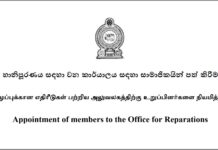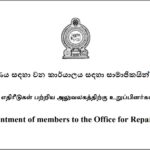A great service established for global shipping in late 1800s which became a centre for regional armed conflict in mid 1900s]
Part 2
Compiled by: Gp Capt Kumar Kirinde, SLAF (Retd)
Egypt’s nationalisation of the Suez Canal Company and the Suez Crisis (1956)
The United Kingdom and the United States pledged to support the construction of the Aswan Dam a gigantic infrastructural project for better control of flooding, provide increased water storage for irrigation and generate hydroelectricity. The dam was seen as pivotal to Egypt’s planned industrialization. However because of Egyptian overtures towards the Soviet Union, both the US and UK withdrew their pledge. Egyptian President Gamal Abdel Nasser then responded by nationalizing the Suez Canal Company which administered the canal and transferring it to the Suez Canal Authority on 26 July 1956. The intention of the nationalisation was to finance the dam project using revenue from the canal.
Then Israel invaded the Egypt’s Sinai Peninsula on 29 October, forcing Egypt to engage them militarily, and allowing the Anglo-French partnership to come into force against Egypt according to the pre-agreed war plans under the Protocol of Sèvres *. The British and the French declared that that the resultant fighting is a threat to stability in the Middle East and thereby making grounds to enter the war – officially to separate the two forces but in reality to regain the Canal and bring down the Nasser government.
* The Protocol of Sèvres was a secret agreement reached between the governments of Israel, France and the United Kingdom during discussions held between 22 and 24 October 1956 at Sèvres, France. The protocol concerns their joint political and military collusion to topple the Egyptian leader Colonel Gamal Abdel Nasser, by invading and occupying the Suez Canal zone in response to President Nasser’s nationalization of the Suez Canal
Accordingly Britain and France issued a joint ultimatum to cease fire, which was ignored. On 5 November, Britain and France landed paratroopers along the Suez Canal. Before the Egyptian forces were defeated, they had blocked the canal to all shipping by sinking 40 ships in the canal.
To save the British from what he thought was a disastrous action and to stop the war from a possible escalation, Canadian Secretary of State for External Affairs Lester B. Pearson proposed the creation of the first United Nations peacekeeping force to ensure access to the canal for all and an Israeli withdrawal from the Sinai Peninsula.
On 4 November 1956, a majority at the United Nations voted for Pearson’s peacekeeping resolution, which mandated the UN peacekeepers to stay in Sinai unless both Egypt and Israel agreed to their withdrawal. The United States backed this proposal by putting pressure on the British government through the selling of sterling, which would cause it to depreciate. Britain then called a ceasefire, and later agreed to withdraw its troops by the end of the year.

Pearson was later awarded the Nobel Peace Prize. As a result of damage and ships sunk under orders from Nasser the canal was closed until April 1957, when it was cleared with UN assistance. A UN force (UNEF) was established to maintain the free navigability of the canal, and peace in the Sinai Peninsula.
Historians conclude the crisis “signified the end of Great Britain’s role as one of the world’s major powers”.
1967 Arab-Israeli War (known as the Six Day War)
In May 1967, Nasser ordered the UN peacekeeping forces out of Sinai, including the Suez Canal area. Israel objected to the closing of the Straits of Tiran to Israeli shipping.
In May 1967, Egyptian president Gamal Abdel Nasser announced that the Straits of Tiran would be closed to Israeli vessels, and subsequently mobilized the Egyptian military along the border with Israel, ejecting the UNEF. On 5 June, Israel launched a series of airstrikes against Egyptian airfields, initially claiming that it had been attacked by Egypt, but later stating that the airstrikes were pre-emptive.
Egyptian forces were caught by surprise, and nearly the entire Egyptian Air Force was destroyed with few Israeli losses, giving Israel the advantage of air supremacy. Simultaneously, Israeli forces launched a ground offensive into the Egyptian-occupied Gaza Strip and the Sinai Peninsula, which again caught the Egyptians by surprise. After some initial resistance, Nasser ordered an evacuation of the Sinai Peninsula. The Israelis continued to pursue and inflict heavy losses on the retreating Egyptian forces, and conquered the entire Sinai Peninsula by the sixth day of the war.
Israeli forces then went on to occupy the Sinai Peninsula, including the entire east bank of the Suez Canal. Unwilling to allow the Israelis to use the canal, Egypt immediately imposed a blockade which closed the canal to all shipping. Fifteen cargo ships, known as the “Yellow Fleet“, were trapped in the canal, and remained there until 1975.
1973 Arab-Israeli War (known as the Yom Kippur War)
On 6 October 1973, an Arab coalition led by Egypt and Syria jointly launched a surprise attack against Israel on the Jewish holy day of Yom Kippur, which had occurred simultaneously with the Islamic holy month of Ramadan in that year. Egyptian and Syrian forces crossed their corresponding ceasefire lines with Israel and invaded the Sinai Peninsula and the Golan Heights, respectively. Following the outbreak of hostilities, both the United States and the Soviet Union initiated massive resupply efforts to their respective allies during the war, which led to a near-confrontation between the two nuclear-armed superpowers

The fighting commenced with a massive and successful crossing of the Suez Canal by the Arab coalition; Egyptian forces crossed the ceasefire lines with Israel and advanced virtually unopposed into the Sinai Peninsula. However, Israel mobilized most of its forces three days later and halted the Egyptian offensive, resulting in a military stalemate. The Syrians coordinated their attack on the Golan Heights to coincide with the Egyptian offensive and initially made threatening gains into Israeli-held territory. After three days of heavy fighting, Israeli forces had pushed the Syrians back to the pre-war ceasefire lines. The Israeli military then launched a four-day-long counter-offensive deep into Syria. Within a week, Israeli artillery began to shell the outskirts of the Syrian capital of Damascus, and Egyptian president Anwar Sadat began to worry about the deteriorating integrity of the Arab coalition’s leadership.
Sadat believed that capturing two strategic mountain passes deeper within the Sinai Peninsula would make the Arab position stronger during post-war negotiations with Israel, and subsequently ordered Egyptian forces to mount another offensive against the Israelis, which was quickly repulsed. Israeli forces subsequently counter-attacked at the seam between the two Egyptian formations, crossed the Suez Canal into Egypt, and slowly began advancing southward and westward towards Suez City in over a week of heavy fighting that resulted in large casualties on both sides.
On 22 October, an initial ceasefire brokered by the United Nations unravelled, with each side blaming the other for the breach. By 24 October, the Israelis had improved their positions considerably and completed their encirclement of the Egyptian Third Army and Suez City, bringing them within 100 kilometres (62 mi) of the Egyptian capital of Cairo. This development led to dangerously heightened tensions between the United States and the Soviet Union (allied with Israel and with the Arab states, respectively) and a second ceasefire was imposed cooperatively on 25 October to officially end the war. Much wreckage from this conflict remains visible along the canal’s edges.
The canal was then reopened by Egyptian President Anwar Sadat aboard an Egyptian destroyer, which led the first convoy northbound to Port Said in 1975.
Expiry of the United Nations Emergency Force (UNEF) mandate in 1979
The UNEF mandate expired in 1979. Despite the efforts of the United States, Israel, Egypt, and others to obtain an extension of the UN role in observing the peace between Israel and Egypt, as called for under the Egypt–Israel Peace Treaty of 1979, the mandate could not be extended because of the veto by the Soviet Union in the UN Security Council, at the request of Syria.
Accordingly, negotiations for a new observer force in the Sinai produced the Multinational Force and Observers (MFO), stationed in Sinai in 1981 in coordination with a phased Israeli withdrawal. The MFO remains active under agreements between the United States, Israel, Egypt, and other nations.
Mine clearing operations at the Suez Canal by the US and the UK (1974–75)
After the Yom Kippur War, the United States initiated Operation Nimbus Moon to clear the mines scattered in the Suez Canal, The amphibious assault ship USS Inchon was sent to the Canal, carrying 12 minesweeping helicopters. These partly cleared the canal between May and December 1974. The British Royal Navy initiated Operation Rheostat in 2 phases. Phase one was carried out for six months in 1974 three mine hunters, the Fleet Clearance Diving Team (FCDT) and HMS Abdiel, a practice minelayer/MCMV support ship were deployed. For phase two carried out for six months in 1975, 4 mine hunters were deployed. Once the canal clearance operations were completed, the canal and its lakes were considered 99% clear of mines.
Recent developments related to the Suez Canal
Bypass expansion in 2014
In the summer of 2014, months after taking office as President of Egypt, Abdel Fattah el-Sisi ordered the expansion of the Ballah Bypass from 61 metres (200 ft) wide to 312 metres (1,024 ft) wide for 35 kilometres (22 mi). The project was called the New Suez Canal, as it allows ships to transit the canal in both directions simultaneously. The project cost more than E£59.4 billion (US$9bn) and was completed within one year. Sisi declared the expanded channel open for business in a ceremony on 6 August 2015.
Obstruction by an ultra-large container ship in 2021
On 23 March 2021, at around 05:40 UTC (07:40 local time), the Suez Canal was blocked in both directions by the ultra-large Golden-class container ship Ever Given. The ship, operated by Evergreen Marine, was en route from Malaysia to the Netherlands when it ran aground after strong winds allegedly blew the ship off course. Upon running aground, Ever Given turned sideways, completely blocking the canal. Although part of the length of the canal is paralleled by an older narrower channel which can still be used to bypass obstructions, this particular incident happened in a section of the canal with only one channel.

When the incident began, many economists and trade experts commented on the effects of the obstruction if not resolved quickly, citing how important the Suez was to global trade; the incident was likely to drastically affect the global economy because of the trapped goods scheduled to go through the canal. Among those goods, oil shipments were the most affected in the immediate aftermath, due to a significant number still blocked with no other way to reach their destination. The International Chamber of Shipping (ICS) estimates that up to $3 billion worth of cargo passes through the Suez Canal every day.
It was said the blockage would have an impact on cargo schedules around the world. Shipping companies were also considering whether to divert their ships along the much longer route around the Cape of Good Hope. The first container ship to do so was Ever Given‘s sister ship, Ever Greet.
The ship was re-floated on 29 March. Within a few hours, cargo traffic resumed, slowly resolving the backlog of around 450 ships. The first ship to successfully pass through the canal after the Ever Given‘s recovery was the YM Wish, a Hong Kong-based cargo ship.
After the incident, the Egyptian government announced that they would be widening the narrower parts of the canal. On 2 April 2021, Usama Rabie, chairman of the Suez Canal Authority of Egypt, said that the damage caused by the blockage of the canal could reach about $1 billion.
On 28 August 2021, the largest containership in the world, the 24,000 TEU Ever Ace, crossed the Suez Canal for the first time. The ship built by South Korean shipbuilder Samsung Heavy Industries (SHI) is owned by Evergreen Marine Corporation of Taiwan.
Source: https://en.wikipedia.org/wiki/Suez_Canal












